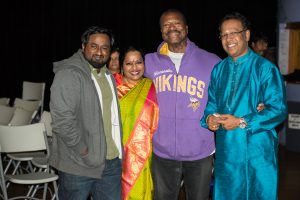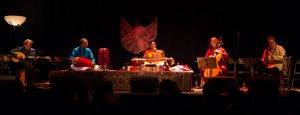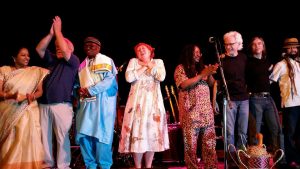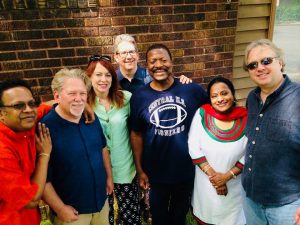
The Wonderful/Wretched Memories of Racial Dynamics in the Twin Cities, Minnesota special feature publishes stories of social scientists with ties to the Twin Cities of Minneapolis and St. Paul but now live elsewhere. My family and I have lived in Minneapolis since 1994, but I was inspired to submit this essay to highlight a dynamic that has not yet been explored: the experiences of South Asians. I wasn’t born in the United States, but everything else in my life from potty-training onwards happened here. Indeed, my Midwestern accent with a hint of Minnesotan dialect (ya betcha!) has thrown many for a loop. We were far from the first people from India to live in the Twin Cities, and I’ve met many other second-gen Indian immigrants (nicknamed “ABCDs”) who are decades older than me. Yet, over twenty-five years after we unpacked the boxes in our first apartment–a one bedroom in Brooklyn Park—I still have encounters where people comment on how impressed they are by my English fluency; many of these people are well-intentioned and several are not.
“Where are you from?”
“Minneapolis.”
“No, where are you really from?”
*rolls eyes* “India.”
My family is from the Mylapore neighborhood of Chennai, the capital city of the state of Tamil Nadu, the southernmost state in the Republic of India, a country of over a billion people, fifty languages, and many different religions. To reduce that diversity to the one-word answer of “India” is a disservice, but a prudent maneuver in a world full of “Where are you from?” and the annoying follow-up question. After all, most people living in the USA do not have the experience to learn about the diversity of the Indian sub-continent and South Asian culture. Sometimes, when I’m feeling cheeky, I answer “Sri Lanka” or “Pakistan” instead.
Of course, the one-word answer of “Minneapolis” is in itself another disservice. What does it mean to be from Minneapolis when “Minneapolis” can span from affluent suburbs such as Eden Prairie, Wayzata, and Eagan, or “Minneapolis” can mean the “less affluent” neighborhoods such as Cedar-Riverside, North, and Phillips? Indeed, how can we squeeze the entirety of the Twin Cities into words like “Minneapolis” or “St Paul?”
When my parents moved to Minneapolis, they were no strangers to being foreign internationals in a different land. Between the two of them, my parents had lived in Iran, England, Switzerland, and several other countries beforehand. Yet, when I was discussing thoughts about race with my parents as I planned this essay, something my mother said struck me: “It took us a little while to learn about race in this country and this city. It’s not the same as elsewhere.” After all, the culture here was not a foreign concept, given the international presence of all things American from Michael Jackson to Kentucky Fried Chicken. The image of the United States in the early 1990s was that of a modern, cosmopolitan, self-proclaimed post-racist society; this was a defining narrative in American media, politics, and news, and my parents say this had given them high expectations for tolerance and racial harmony in this advanced multicultural nation. But, this certainly wasn’t the case; discrimination, prejudice, and the differing conduct and interactions between varying racial groups soon became clear.

My mother, an internationally-acclaimed Carnatic musician, quickly learned the scales of race and racism in the USA and the Twin Cities. Her instrument, the veena, is as large as a jazz bass. She has travelled around the world for her music, no thanks to the efforts of TSA agents. She recounted a story to me when she and her friend, a White cellist, were flying to California in the mid-2000s with their instruments. The TSA agents barely glanced at the cello, not evening opening its case to check inside. But, they unceremoniously dragged my mother’s instrument from the box and threw it forcefully on the examination table. They made her take the strings off and separate the wood holding the sound chamber together so they could look inside. They looked at the ornate symbols, patterns, and calligraphy upon the veena itself with disgust. My mother, used to this behavior, was upset but tried to put it out of her mind and focus on inspecting the veena for damage. Her friend was so horrified that she immediately drafted a letter to the airline staff demanding an apology and explanation, sending several letters over a few weeks, but she never received a response.
I have learned a lot about race as a result of my mother’s music. Indeed, the social circle of musicians she knew was a diverse affair, including Robert Bly the celebrated poet, Marcus the White man who plays the Indian drum tabla, Hong the Chinese woman who plays an Asian lute called a pipa, Gary the Black leader of the world-class group Sounds of Blackness, David the Sephardic scholar and musician, Nicole the inspiring White, deaf actor, as well as Indian theatre director Dipankar, and dancers Ranee, Rita, and Ananya who hail from many different parts of India …this is just the tip of the iceberg.Through meeting artists from around the world who represented the intersections of various cultures and experiences, my understanding grew. I gained an appreciation for foods, music, and arts outside my own group. As a young child I received the kinds of formative experiences that helped me respect people who didn’t look like me. When I think back to the kids in high school who made fun of my race, my funny-sounding name, the ‘smelly’ lunches my parents packed, and the weird clothes my people wear, I wonder if they ever had the same chance as I did to learn better.

Some of the most important parts of my learning about diversity and race came from insights from Black musicians in Minneapolis. Anthony, a nationally known, legendary Black jazz bassist, shared insightful and painful recollections of his experiences performing with my Mom, tales which trickled to me as I got older and gained understanding. His family moved to Minneapolis when he was the same age that I was when my family moved to Minneapolis. They came from Oklahoma in the 1950s whereas we came from Switzerland in the 1990s, but their story taught us a lot about race in the USA and Minneapolis. Anthony’s family faced the racism and hostility of pre-Civil Rights era White America. As he describes, “Minnesota nice” wasn’t nice to him or his family. Though his parents worked as servants and laborers in the Jim Crow South, they experienced new kinds of racial aggression and humiliation in Minnesota which they had not experienced in Oklahoma. The air of “you’re-different-than-me” felt more palpable here where Whiteness was an overarching default and minorities of any kind were an oddity. The only thing colder than the Minnesota winters was the frigid-at-best treatment Anthony’s family received from their neighbors when they bought their first house in an all-White neighborhood. I had convinced myself that the bullies from my youth gave me the same insight into being a minority as all other minorities. Spending time with Anthony (“Anthony Uncle,” as I called him then) was part of my broader awakening to the fact that POC don’t all share the same experience when dealing with Whiteness. His tales made my lunchroom bullies look like Mother Teresa. For perspective, consider that his family received so many violent threats that the Attorney General ordered a protective detail and had to use wiretaps to trace the origin of such threats.
When we think about “race” from an academic lens, we can see that this little four-letter word captures many different sociological concepts and constructs in empirical data and research. Here, I turn to C.W. Mills’ famous “sociological imagination.” The impacts of race and racism in history perfectly show the power and importance of social constructions; race is a concept which provides a myriad of opportunities to exercise and awaken the sociological imagination; the history of efforts, energies, and excellence of anti-racist scholars has been a foundational building block in forwarding critical social science as a vehicle of equity, change, and social good.If I have to pick the earliest moment when my own sociological imagination was sparked, it comes from hazy memories of the multiethnic, multiracial apartment complex we first lived in during my preschool and early days of K-12. This neighborhood in Brooklyn Park would prove a thousand times more diverse than the sprawling White suburbs such as Wayzata, Eden Prairie, and Edina where we lived for the majority of my early education. White families, Chinese families, Hmong families, Vietnamese families, Mexican families, Nicaraguan families, Black families, and many more lived in these affordable apartments, and many were other immigrant families. Indeed, we were far from the only Indian family in the neighborhood as well. A veritable hodgepodge of diverse, five-year old boys could be seen running around the apartment complex at any given moment, playing tag and Power Rangers.
I have a vague memory, corroborated by my parents’ recount of the story. Another Indian kindergartener and I were riding the bus to school in the morning. Every morning, a teacher would board the bus and call, “Breakfast students!” Some students would get off the bus and follow her. One day, my Indian friend and I joined that line of students; our youthful curiosity was dying to know what was going on there. We were led into the school cafeteria, where there were cinnamon rolls and cartons of milk. My friend and I weren’t hungry; we threw away most of our serving. Little did we know, we were encroaching on the designated space for providing free or reduced-cost meals for low-income students.Our families were not on the designated list, nor were any other Indian students. My friend and I received quite the scolding for our little adventure after the school called to report our mischief. I remember what stood out to me about the experience, though I didn’t have the understanding as a five-year-old to put it into articulate words. In the language of a kindergartner, I noticed that my friend and I were the only other desi kids sitting with the “Breakfast students.” Looking back on this story today as a sociologist who studies race, this moment was one of my first in learning the scales of race in the USA. Despite the racial diversity on the bus ride to school, in the kindergarten classroom, and in the apartment complex during the many afternoons spent playing tag, the “Breakfast Students” was a nearly all-Black group, and notably none of the many other Indian immigrant families in the neighborhood had children enrolled in this presumably needs-based program.
In many ways, this anecdote captures the power of diversity to foster inter-racial understanding and cooperation, but the shortcomings of diversity for truly pursuing racial equity and structural change. This is a common theme in research about “diversity” discourse today. Research establishes that diversity is good. Diversity can breed inter-group friendships and understanding. Diversity can give us opportunities to learn about new cultures. Diversity can make organizations more creative and make groups more productive. Yet, diversity is not a panacea for racism or the ticket to racial inequality. In fact, another common theme in research about diversity discourse is that such language can be used in ways which celebrate race yet downplay racial inequality and deny the continued relevance of race and racism in the USA. I had a fun time playing with the other neighborhood kids and developing a taste for tacos, chicken, and banh mi when the other parents had us over for lunch. But at that age, I never once realized that that some of the other kids would go on to face challenges I could never dream of. I never thought about why some of them ate breakfast at school.Thus, though I have discussed “diversity” as a tool which can create more harmonious inter-racial understanding, diversity falls far short of fostering the critical, anti-racist energies that we need today in order to dismantle systems of White supremacy. Living in Minneapolis has taught me that we must leverage our diversity as solidarity. The hodgepodge of different ethnicities, cultures, and communities which defined my family’s old apartment in Brooklyn Park characterizes the Twin Cities; for a relatively small urban area in comparison to major metropolitan hubs in the United States, Minneapolis still sports its fair share of ethnic and racial diversity. Yet, it is amidst this very diversity that George Floyd was murdered and Black lives have been harassed, terrorized, and ended at the hands of systemic state violence.

In the weeks following protests for George Floyd, my mother and her music school Naadha Rasa organized funds for community relief and supporting peaceful protesters; when she took bags of food to the drop-off point complete with COVID precautions, she saw a diverse group of people standing in the streets in support of the #BlackLivesMatter movement. She stayed and participated for a while; her work had always placed her in a position to foster inter-racial friendships and understanding, but today her instrument was not her veena, but her support for the movement. Leveraging the diversity of music and art gives us the opportunity to learn the scales of race, but it is time to move further.
We must not only learn the scales of race, but we must work to transform the score that these notes are written upon so that murky and jarring low-notes become melodious and clear high-notes. We must recognize systemic racism for what it is: an overarching, life-defining soundtrack, a theme song for the USA. For many POC in this country living under the specter of systemic racism, a large part of their existence has been trying to convince media, politicians, academics, and their own friends that that race still matters; this issue clearly persists today. Changing this tune will require all of us as a society, but doesn’t the best music come when we put our heads together?
Minneapolis, MN
July 21, 2020
Previous Reflection Next Reflection
Return to the Wonderful/Wretched Series introduction.
